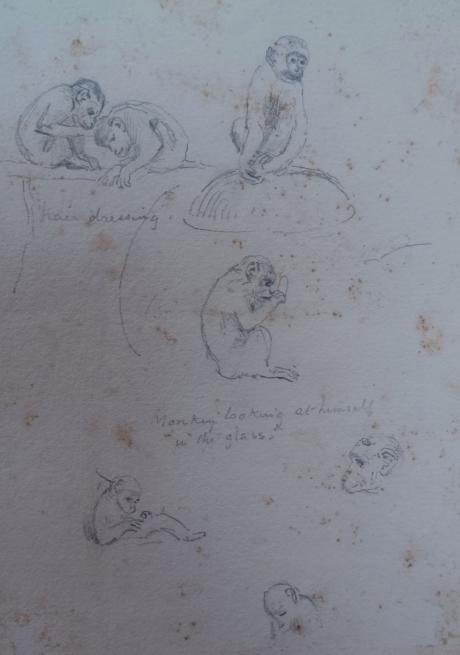inscribed as title
The macaques constitute a genus (Macaca) of gregarious Old World monkeys of the subfamily Cercopithecinae. The 23 species of macaques inhabit ranges throughout Asia, North Africa, and Europe (in Gibraltar). Macaques are principally frugivorous (preferring fruit), although their diet also includes seeds, leaves, flowers, and tree bark. Some species such as the long-tailed macaque (M. fascicularis; also called the crab-eating macaque) will supplement their diets with small amounts of meat from shellfish, insects, and small mammals. On average, a southern pig-tailed macaque (M. nemestrina) in Malaysia eats about 70 large rats each year. All macaque social groups are arranged around dominant matriarchs.
Macaques are found in a variety of habitats throughout the Asian continent and are highly adaptable. Certain species are synanthropic, having learned to live alongside humans, but they have become problematic in urban areas in Southeast Asia and are not suitable to live with, as they can carry transmittable diseases.
The first structure to be completed was the Mappin Terraces in 1914, impressive and innovative at the time but a nightmare, like so many buildings at London, for future generations, as a legally preserved edifice that proved unsuitable for housing most of the animals they were intended for. Progress in changing London Zoo was then delayed by the First World War. Primates—highly susceptible to tuberculosis—were a priority. The new Monkey House (opened in 1927) was preceded by Monkey Hill (1925) designed as an open air pit-like enclosure with a spectacular rockwork centre. The Hill was to house a large group of Hamadryas Baboons (Papio hamadryas). Hagenbeck already had one; indeed they had brought another to London from Germany in the winter of 1913/14 for a Christmas Zoo and Circus at Olympia containing over a hundred animals.
Monkey Hill was a 100 x 60 ft oval. The central rockwork was surrounded by a ditch 18 ft wide with a 12 ft deep outer wall over which visitors could view the hill from all sides. Every effort was made to provide features which would overcome some of the problems thought to be the result of keeping animals in stuffy houses. What must have been a fairly large shelter inside the hill was heated. Ultraviolet-emitting quartz bulbs played on shelves and perches. Some of the ledges on the outside were also heated and equipped for ultraviolet radiation, in order to try to prevent that other scourge of primate (including human) populations lacking sunlight, rickets.
Animals were ordered from Chapman, the animal dealer of Tottenham Court Road, caught in Abyssinia and shipped to London. The Hagenbecks had advised that only males be kept. In the event 100+ baboons arrived at the Zoo and Chapman was paid £850 (£43,000 at 2015 prices). But six females, some with young, had also arrived as part of the batch. After the release onto the hill of the males, in two batches, the females were added. All hell broke loose.
Lionel Grimston Fawkes, grandson of Walter Ramsden Hawkesworth Fawkes (an MP and patron of Turner), began his military training at the Royal Military Academy, Woolwich, he became professor of military topography there... By 1883 he was Dominic Gamble’s aide-de-camp in Jamaica. In 1885 he entered Staff College, Sandhurst. He became a Colonel in the Royal Artillery and later a Justice of the Peace. In 1891 he married Lady Constance Eleanor Kennedy, daughter of a Scottish peer. He was Professor of Military Topography at the Royal Military Academy from 1895 to 1900. By 1923 he and his wife had moved to Canada, purchasing the Point Comfort Hotel on Mayne Island and changing its name to Culzean after Constance’s ancestral home, Culzean Castle. They remained at Culzean for the rest of their lives.
Colonel Fawkes was a very accomplished artist and illustrator. His water-colours are held in collections around the world. Their married daughter, Lois died in 1919 leaving a one year old son Lawrence. Tragedy struck the Fawkes family again in 1921, when their other daughter, Monica, also died. This was all too much for the Colonel and Lady Constance and in 1924 they emigrated to Mayne Island, British Columbia with their son-in-law and grandson.

